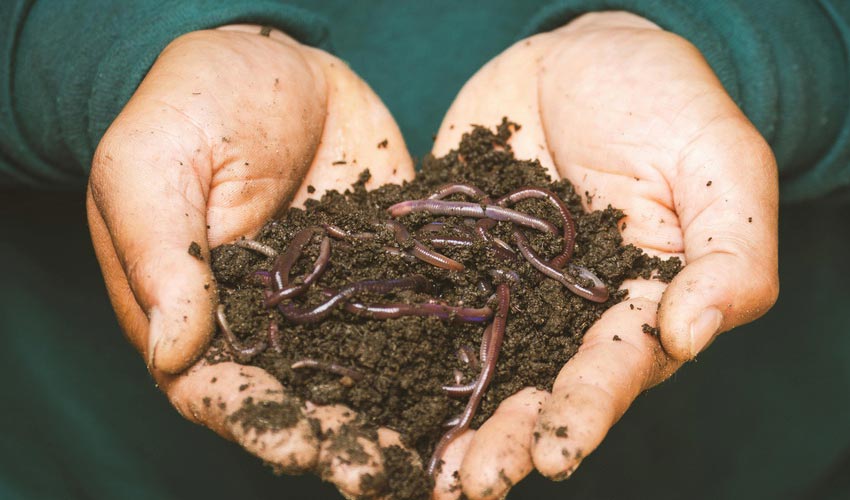Boluoke - The Lumbrokinase Extract that's Changing the Game
As a child, I have vivid memories of scouring the lush expanse of our back garden, my heart racing with excitement at the prospect of discovering the great, wriggling treasures lurking just beneath the surface. The soil there was nothing short of magical, a rich, almost black earth that seemed to breathe life into everything it touched. It was teeming with nature’s wonders, including countless hefty earthworms. I would eagerly dig my hands into the cool, damp soil, feeling the thrill of finding these squirming creatures, perfect for baiting hooks on lazy summer afternoons by the nearby river. With each earthworm I caught, I couldn’t help but appreciate their robust form and vibrant movement. They were a vital part of my childhood adventures, transforming simple fishing trips into memories I cherish to this day. Who could have imagined that those little creatures, seemingly so insignificant, would play a much larger role in my life many years down the line?
Fast forward to adulthood, I stumbled upon a fascinating revelation: those very earthworms I once caught as a kid were not only excellent fishing bait but also a potent source for creating a remarkable natural health supplement. It turns out that these resilient beings are packed with nutrients and compounds that offer a myriad of health benefits. Their ability to enhance soil fertility and contribute to environmental health is just a fraction of their significance. This newfound understanding of earthworms, these creatures that once served merely as bait, opened my eyes to their incredible potential as supplements that harness the power of nature to promote overall well-being. It’s astounding how the simple joys of childhood, grounded in the earthy embrace of our garden could lead to such a profound appreciation for the natural world and its hidden treasures. What was once a carefree pastime now connects deeply to the fields of health and wellness, reminding me of the extraordinary gifts that nature offers us in the most unexpected ways.

The Mighty "Earth Dragon"
Earthworms, known in Chinese as Dilong or "Earth Dragon," have been revered for centuries across China, Japan, and other countries in the Far East, not only as a nutritious food source but also as a cornerstone of traditional medicine. Their use spans thousands of years, highlighting a deep-rooted cultural appreciation for these remarkable creatures. The rich tapestry of traditional healing practices has embraced earthworms for their impressive profile of bioactive compounds, many of which have shown promising medicinal properties. These fascinating organisms are packed with a range of compounds that offer potential therapeutic benefits for a range of health issues. Research has indicated that earthworms can be effective against various inflammatory conditions, hematological disorders, oxidative stress-related ailments, and neurological diseases, thus showcasing their versatility in enhancing human health. Furthermore, earthworms possess antimicrobial, antiviral, and anticancer properties, positioning them as valuable allies in the fight against infections and chronic diseases. One of the standout features of earthworms is their fibrinolytic activity, which plays a critical role in promoting circulatory health. Specific regions of the earthworm, including the pharyngeal region, crop, gizzard, clitellum, and intestine, secrete enzymes that facilitate the dissolution of fibrin, an essential protein involved in blood clotting. This unique enzyme activity not only aids in maintaining healthy blood flow but also supports the body’s natural processes of healing and regeneration.
The utilisation of grounded earthworm powder for oral administration has garnered attention in herbal medicine as a means to bolster circulatory health and treat various blood-related diseases. This innovative approach highlights the importance of earthworms as a natural remedy, appealing to a growing interest in holistic health practices and alternative therapies. As modern science begins to validate traditional wisdom, the earthworm emerges as a crucial candidate for further research, raising the potential for new therapeutic avenues that harness the powerful attributes of this unassuming creature. In summary, the earthworm is more than just a humble soil dweller; it is a remarkable entity steeped in tradition and rich in medicinal promise. From its ancient roots in Asian medicinal practices to contemporary explorations of its potential therapeutic roles, the Earth Dragon continues to intrigue and inspire, offering hope for new ways to enhance health and well-being across cultures.
Lumbrokinase & Lung Cancer
According to recent statistics from the American Cancer Society, lung cancer remains a formidable health crisis in the United States. In 2023, around 238,340 people received a diagnosis of lung cancer, while a staggering 127,070 succumbed to the disease, translating to nearly 350 deaths every day. This grim figure is nearly two and a half times greater than the number of fatalities caused by colorectal cancer, which ranks as the second leading cause of cancer-related deaths overall. It is clear that lung cancer has established itself as the foremost cause of cancer mortality across the globe, affecting both men and women. The mortality trends associated with cancer are significantly influenced by the prevalence of lung cancer. One of the critical challenges in combatting lung cancer is its sneaky nature. Detection and diagnosis in the early stages are notoriously difficult, often resulting in patients being diagnosed only after the cancer has advanced. The majority of lung cancer cases, about 80%, are classified as non-small cell lung cancer (NSCLC), which can be particularly aggressive. Current treatment modalities for NSCLC encompass a variety of approaches: surgical resection, chemotherapy, radiotherapy, targeted therapy, and immunotherapy. Notably, the last two decades have witnessed significant advancements in molecular targeted therapy and immunotherapy for tumours, revolutionising the treatment landscape for advanced NSCLC. These innovative therapies have positively impacted patient outcomes, yet challenges remain.

Despite the advancements, lung cancer treatments are often accompanied by unwanted toxic side effects and the emergence of therapeutic resistance, which can severely impede efficacy and progress the disease. This unfortunate reality contributes to the elevated mortality rates observed in lung cancer patients, particularly those with advanced NSCLC. Therefore, it is imperative to deepen our understanding of the mechanisms that underpin the onset and progression of NSCLC, especially focusing on the molecular pathways related to therapy resistance. This knowledge could pave the way for the development of new adjuvant therapies and optimised combination treatment strategies. An essential aspect of tumour progression is angiogenesis, the growth of new blood vessels that supply malignant cells with the oxygen and nutrients they need to thrive. The process of angiogenesis is crucial for tumour growth and metastasis. Recently, researchers have concentrated efforts on targeted therapies aimed at inhibiting angiogenic signaling pathways and genes, marking a groundbreaking approach in cancer prevention and treatment. Currently, anti-angiogenic drugs fall mainly into two categories: monoclonal antibodies that target vascular endothelial growth factor (VEGF) or its receptor (VEGFR), and small molecule tyrosine kinase inhibitors that also focus on VEGFR. Among the members of the VEGF family—comprising VEGF-A, VEGF-B, VEGF-C, VEGF-D, VEGF-E, and placental growth factors (PIGF-1 and PIGF-2)—VEGF-A stands out as the most potent promoter of blood vessel growth.
One well-known anti-VEGF treatment, Bevacizumab, has been shown to have clear anti-tumour effects in various malignancies, including NSCLCs. However, the success of anti-angiogenic therapies is often shadowed by increased tumor aggressiveness and the development of resistance over time. Furthermore, these treatments can lead to severe side effects, such as significant bleeding and heightened risks of thrombosis, attributable to changes in endothelial cells and the release of various cytokines. Consequently, current research is urgently focused on how to mitigate these toxic effects, prolong the efficacy of treatments, and enhance overall clinical outcomes for patients. Chemotherapy remains a cornerstone treatment for lung cancer, including NSCLC. It is commonly used as adjuvant therapy following surgical resection, as well as a palliative option for patients facing advanced stages of the disease. While chemotherapy can alleviate cancer-related symptoms and extend overall survival, patients often develop drug resistance over time, leading to treatment discontinuation and ultimately resulting in disease relapse and metastasis. Moreover, traditional chemotherapy drugs are not specific to cancer cells and can inadvertently harm healthy cells, sometimes shortening patients' survival times.
To overcome these challenges, researchers are exploring the combination of chemotherapy with other treatment modalities, such as immune checkpoint inhibitors and tyrosine kinase inhibitors. Emerging clinical studies suggest potential benefits from these combination therapies. In addition, integrating alternative treatments like traditional Chinese medicine anti-cancer therapies into comprehensive treatment plans could enhance outcomes for NSCLC patients. In summary, understanding the multifaceted challenges of lung cancer, from its aggressive nature to the hurdles presented by current treatment options, is crucial. By unraveling the complexities of NSCLC, we can strive toward the development of more effective and less harmful treatments that ultimately improve patient survival and quality of life.

Why Lumbrokinase Can Help?
Earthworm fibrinolytic enzyme (EFE), known as Lumbrokinase, is a sophisticated enzyme derived from Earthworms through established, standardised extraction methods. This powerful enzyme not only acts as a potent plasmin, an enzyme that breaks down blood clots, but also plays a significant role in enhancing anticoagulation effects by inhibiting the function of platelets. For many cancer patients, particularly those with advanced stages of the disease, there lies a significant risk of hypercoagulability, which is an increased tendency for blood to clot. This condition can often lead to venous thromboembolism, a serious complication that can impede treatment and worsen patient outcomes. Research indicates that this hypercoagulable state is closely linked to tumour growth and metastasis, meaning that the tendency for blood to clot can actually stimulate the spread of cancer. Therefore, using anticoagulants like Lumbrokinase to mitigate these risks associated with cancer is a promising approach. Moreover, there is a growing interest in whether Lumbrokinase could also play a role in directly inhibiting tumour progression, particularly in patients with non-small cell lung cancer (NSCLC), a common and aggressive form of lung cancer. Several studies have already shown that Lumbrokinase may inhibit the growth and spread of various types of cancer cells, including those from bladder, gastric, and liver cancers, although much of this research is still in its early stages.
Notably, one of the potential benefits of Lumbrokinase is its ability to counteract the increased risk of thrombosis associated with treatments like bevacizumab, a therapy commonly used for NSCLC. Given its natural origin, low toxicity, and potential anti-cancer effects, Lumbrokinase could also help mitigate some of the adverse effects of chemotherapy while potentially delaying the onset of chemo-resistance, the cancer’s ability to become resistant to treatment. In the research I studied they set out to systematically investigate the combined treatment strategies involving Lumbrokinase with either bevacizumab or traditional chemotherapy for NSCLC patients. To do this, researchers conducted a series of laboratory experiments to explore the effects of Lumbrokinase on NSCLC cells. Our findings revealed that Lumbrokinase effectively reduces the expression of a protein known as BPTF. This reduction leads to decreased binding of BPTF to a specific region of the VEGF gene, which in turn lowers VEGF expression, an important factor in tumour blood supply and growth. This mechanism highlights how Lumbrokinase can synergize with bevacizumab, enhancing the treatment of NSCLC.
Additionally, research indicated that treatment with Lumbrokinase also leads to the inactivation of NF-κB signaling. This process alleviates the binding of specific proteins to the COX-2 gene promoter, which ultimately decreases COX-2 levels. The importance of this finding lies in the fact that it enhances the sensitivity of NSCLC cells to chemotherapy, presenting yet another avenue through which Lumbrokinase can potentially improve treatment outcomes. In summary, research aims to delve deeper into the anti-tumour effects of Lumbrokinase and the underlying molecular mechanisms by which it suppresses angiogenesis, the formation of new blood vessels crucial for tumor growth and combats the development of chemo-resistance. Based on my findings, researchers propose that combining Lumbrokinase with treatments like bevacizumab or chemotherapy could represent a novel and effective approach to treating NSCLC.

Boluoke® Lumbrokinase Extract's Health Benefits
In the pursuit of optimal health and wellness, people and healthcare professionals alike are increasingly looking towards natural remedies and supplements that are backed by scientific research. One such substance that has garnered attention over recent years is Boluoke® Lumbrokinase Extract. Derived from earthworms, this enzyme blend is a powerful fibrinolytic agent that offers a plethora of potential health benefits, particularly in the field of cardiovascular health and beyond. (Fibrinolysis is an essential physiological process that helps maintain our body's delicate balance by preventing the excessive growth of natural blood clots, which could lead to serious complications. This process unfolds in two distinct forms: primary fibrinolysis, where the body efficiently breaks down clots as part of its routine function, and secondary fibrinolysis, which occurs when an underlying medical condition, medication, or other factors trigger the breakdown of blood clots. Understanding these mechanisms is crucial for appreciating how our bodies safeguard against potential health risks.)
What Exactly is Boluoke® Lumbrokinase Extract?
Boluoke® is a brand of Lumbrokinase, a type of enzyme harvested from the earthworm species Lumbricus rubellus. This enzyme complex is primarily known for its ability to break down fibrin, a protein involved in blood clotting. By promoting fibrinolysis, the process of dissolving excess fibrin, Bouloke® Lumbrokinase has emerged as a natural alternative to synthetic thrombolytic drugs, which can come with a host of side effects.
The Mechanism of Action
Lumbrokinase works by activating plasminogen to plasmin, an enzyme that plays a crucial role in the body's natural breakdown of blood clots. This action helps enhance blood circulation and reduces the risks associated with clot-related conditions, such as thrombosis and stroke. Additionally, Lumbrokinase has been shown to have anti-inflammatory properties, which can further support cardiovascular health and improve overall well-being. Let’s have a look of the health benefits.
Improved Cardiovascular Health: The most significant health benefit associated with Boluoke® Lumbrokinase Extract is its positive impact on cardiovascular health. By promoting the breakdown of blood clots, Lumbrokinase helps to: Reduce the Risk of Heart Attack & Stroke: Thrombosis, or blood clots, is a leading cause of heart-related diseases. Lumbrokinase’s fibrinolytic activity can help reduce the incidence of sudden cardiovascular events by keeping blood vessels clear. Manage High Blood Pressure: Studies suggest that improved blood flow can lead to lower blood pressure levels, thus reducing strain on the cardiovascular system. Lower Cholesterol Levels: Some preliminary research indicates that enzyme therapy may aid in controlling overall cholesterol levels, improving overall heart health.
Enhancement of Blood Circulation: Improved blood circulation not only aids in cardiovascular health but also has several cascading benefits throughout the body: Improved Oxygen Delivery: Enhanced circulation ensures that oxygen and nutrients reach vital organs and tissues, promoting better function and recovery. Accelerated Healing: With better blood flow, the body can expedite recovery from injuries or surgeries, as essential nutrients and immune cells reach damaged areas more effectively.
Anti-Inflammatory Effects: Boluoke® Lumbrokinase has shown promise in reducing inflammation, which is a root cause of many chronic diseases. Some potential benefits include: Reduction of Chronic Pain: Inflammation is often tied to conditions such as arthritis and fibromyalgia. By mitigating these inflammatory processes, Lumbrokinase may help alleviate accompanying pain. Support for Autoimmune Conditions: Enhancing the body’s natural anti-inflammatory responses can be beneficial for people suffering from autoimmune diseases.
Potential Support for Diabetic Patients: There's emerging evidence that Lumbrokinase can be beneficial for people with diabetes. By improving circulation and reducing oxidative stress, this enzyme may help manage complications often associated with diabetes, including: Diabetic Neuropathy: Enhanced blood flow may slow the progression of nerve damage due to diabetes. Wound Healing: Improved circulation is critical for faster healing of diabetic ulcers and other wounds.
Neuroprotective Properties: Recent studies suggest that Lumbrokinase may have neuroprotective effects. By enhancing cerebral blood flow, it may help combat neurodegenerative conditions. While research is still ongoing, some proposed benefits include: Improved Cognitive Function: Enhanced blood flow to the brain can lead to better cognitive performance, including memory and focus. Potential in Stroke Prevention: Lumbrokinase's ability to reduce clot formation is crucial in lowering the risk of strokes, which can lead to cognitive decline.
Safety & Dosage
Boluoke® Lumbrokinase Extract is generally regarded as safe for most people. However, it is important for users to consult with healthcare professionals, particularly if they have underlying health conditions or are taking blood-thinning medications. Dosage typically varies depending on individual health needs and the specific formulation of the product. A common dosage is around 20 mg per day, but this may vary.

Boluoke® (lumbrokinase) stands out as the only thoroughly researched oral enzyme available, designed to promote a healthier blood state. Its remarkable efficacy in fostering a balanced coagulation and fibrinolysis process in the body showcases its potential to support optimal cardiovascular health. Ancient Purity gives you the option to experience the benefits of Boluoke® and empower your wellness journey today!
“I must own I had always looked on worms as amongst the most helpless and unintelligent members of the creation; and am amazed to find that they have a domestic life and public duties!” - Joseph Hooker, 19th century British botanist






















